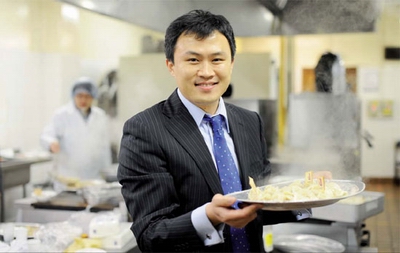
Spring Festival in China is a time for family gatherings, parties and food - usually lots of it. The traditional festival dish is dumplings, filled with meat and vegetables, which family members either make themselves or buy ready prepared.
Dumplings were created by Zhang Zhongjing during the Eastern Han Dynasty (AD 25-220), originally as a treatment for frostbite.
Their shape is similar to the gold ingots used as money in ancient China since the Ming Dynasty (1368-1644), and because of this they became associated with good fortune and a staple Spring Festival dish.
The association with wealth continues today. Some families put a gold coin inside one dumpling and whoever finds it is supposed to have a prosperous year ahead.
China's obsession with dumplings can be seen in massive consumption figures, according to Gary Chu, president of General Mills' Greater China, whose Wanchai Ferry dumpling brand accounts for 44 percent of all frozen dumpling sales in China.
Dumpling sales soar across China at Spring Festival, which is also known as Chinese New Year, and they are on the rise in overseas markets too, says Lan Jian, founder and managing director of Freshasia Foods Ltd, a wholesale chain selling dumplings and hotpot ingredients in East London.
When Lan founded Freshasia four years ago, his team was making 30,000 dumplings a day, but that has risen to about 150,000, with some exported to other parts of Europe, including Germany, Spain, Ireland, France and Switzerland.
"Westerners have developed a preference for authentic Chinese food in recent years," he says. "Hence, people in our industry have developed the saying 'cultural food is international food'."
Freshasia's dumplings are all handmade and retain their shape better than machine made ones, says Lan.
"I established Freshasia because I realized there was a gap in the market for hand-made dumplings, which taste more authentic," he says.
"And I'm glad that through my work, Westerners now have access to authentic Chinese food."
Traditional Chinese ingredients, such as chicken and mushroom, and sweetcorn and prawn, have proved popular with Western audiences, he says. Spinach is also a favorite.
In China, dumplings come filled with a wide variety of ingredients. The most common are pork and cabbage and the dumplings are either boiled, fried or steamed.
While dumplings look fairly simple, making them is a long and arduous task. To speed things up Lan's company makes dumplings with extra-thin skins that will cook in eight minutes.
"In the past, Western consumers did not see dumplings as something to have for a main meal; they would see it as a side dish," he says. "By introducing easy-cooking dumplings and a range of flavors, they are now having dumplings for lunch."
Most of Freshasia's dumplings are sold in Chinese supermarkets, but Lan has ambitions to get them onto the shelves of Western supermarket chains such as Tesco and Asda.
As well as a growing Western consumer base, Lan's dumplings have found an audience among Europe's rising Chinese student population. To reach out to them further, Freshasia is sponsoring Chinese New Year celebrations at a number of British universities, in the hope that students will taste the company's hand-made dumplings and come back for more.
"As a Chinese person living in the UK, I want not just to sell my products but to do something for the Chinese community too. So maybe this is a small contribution I can make," Lan says.





